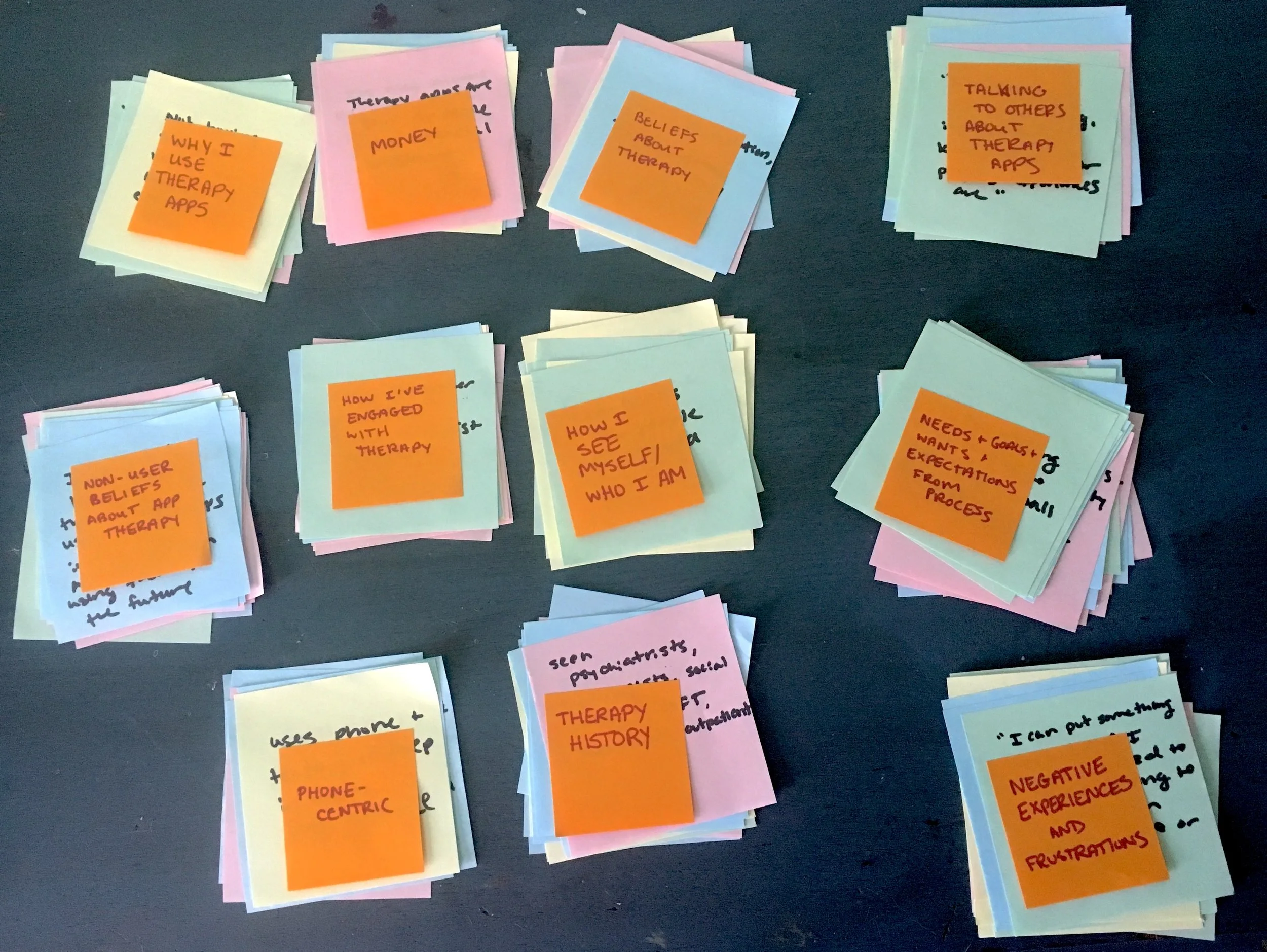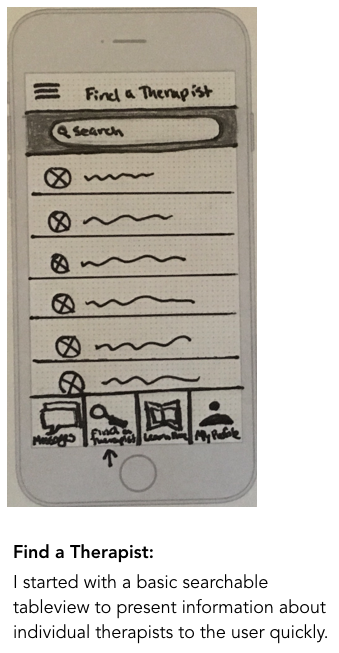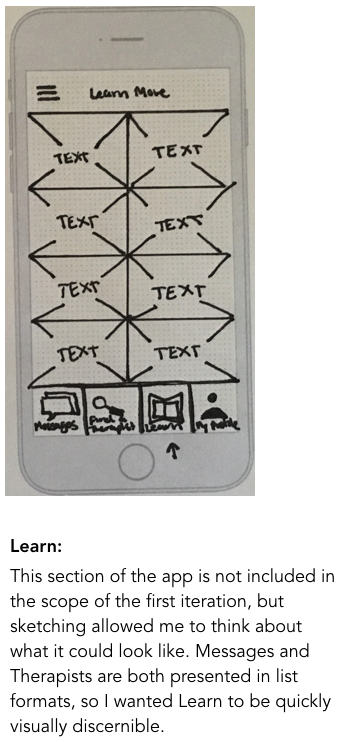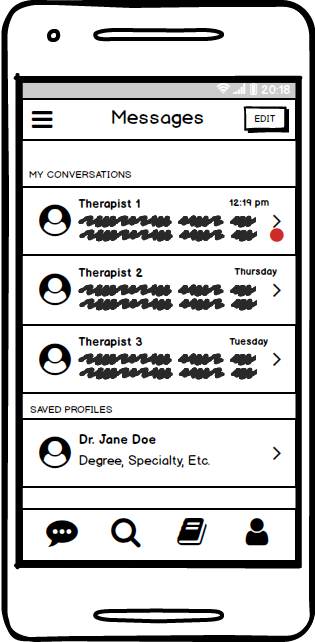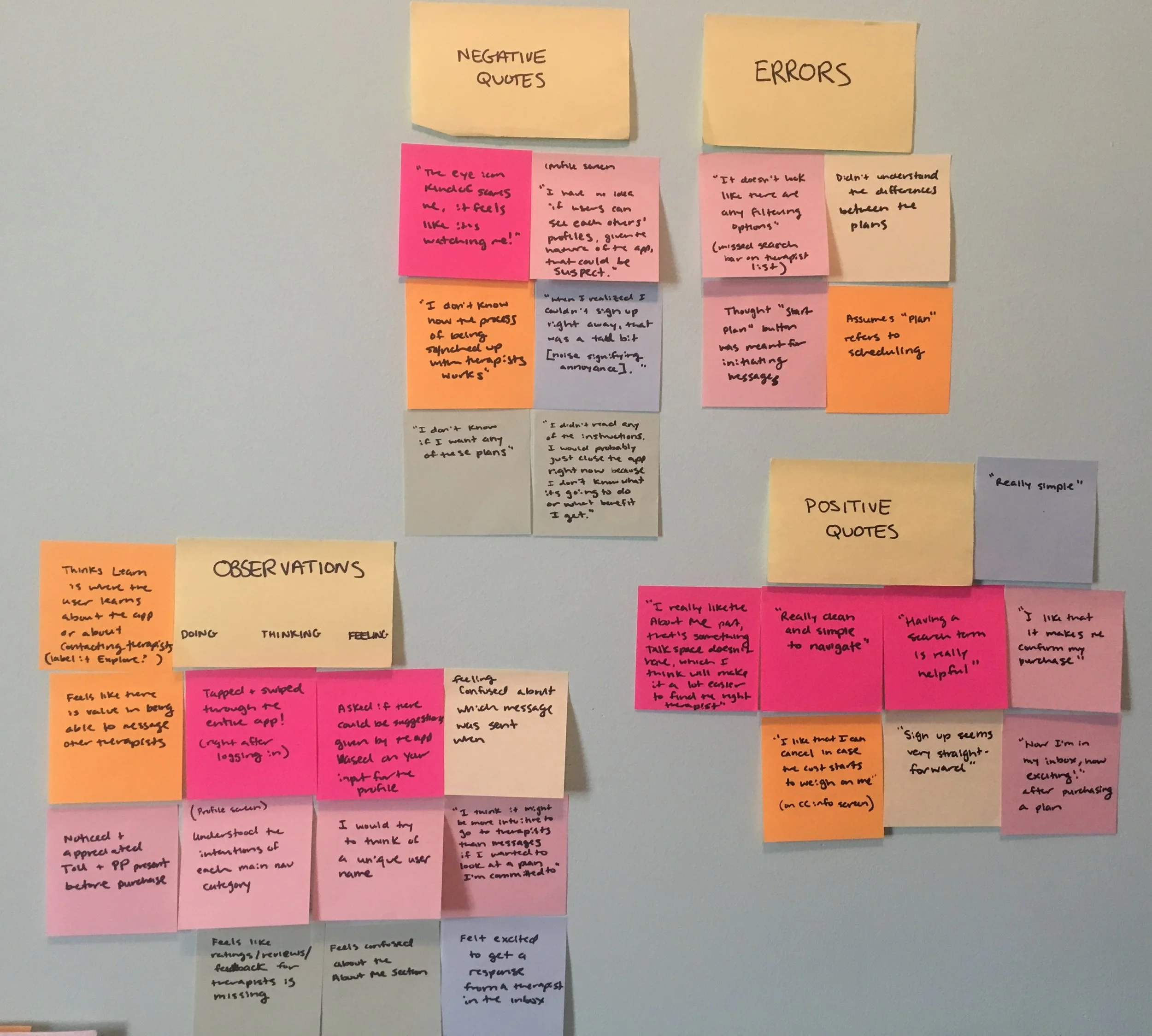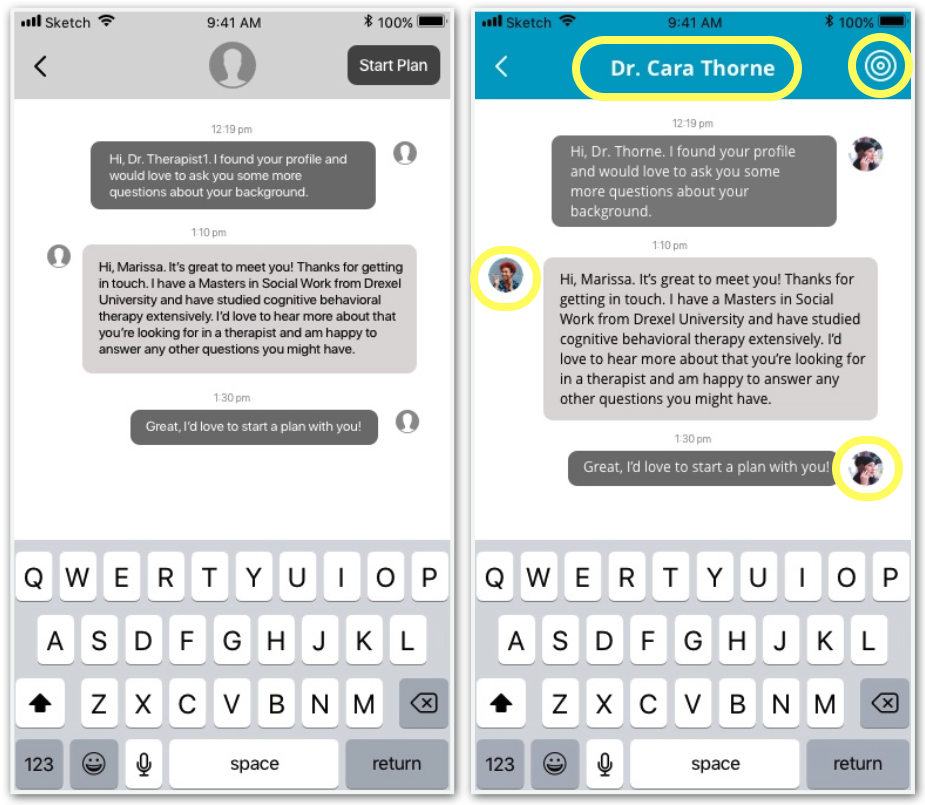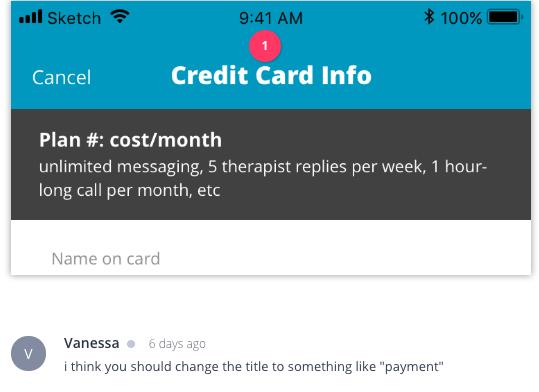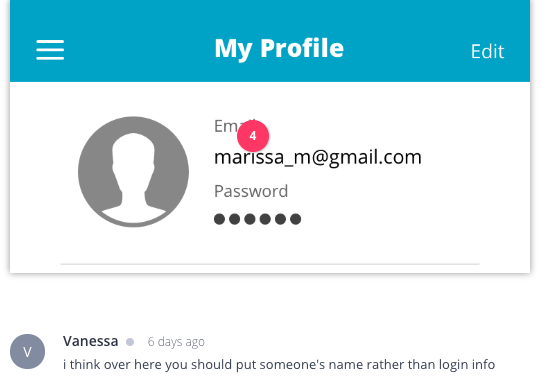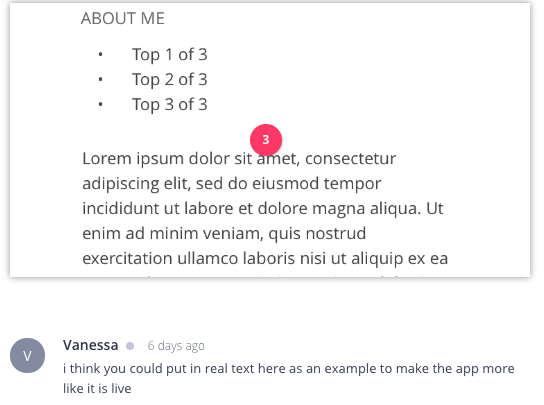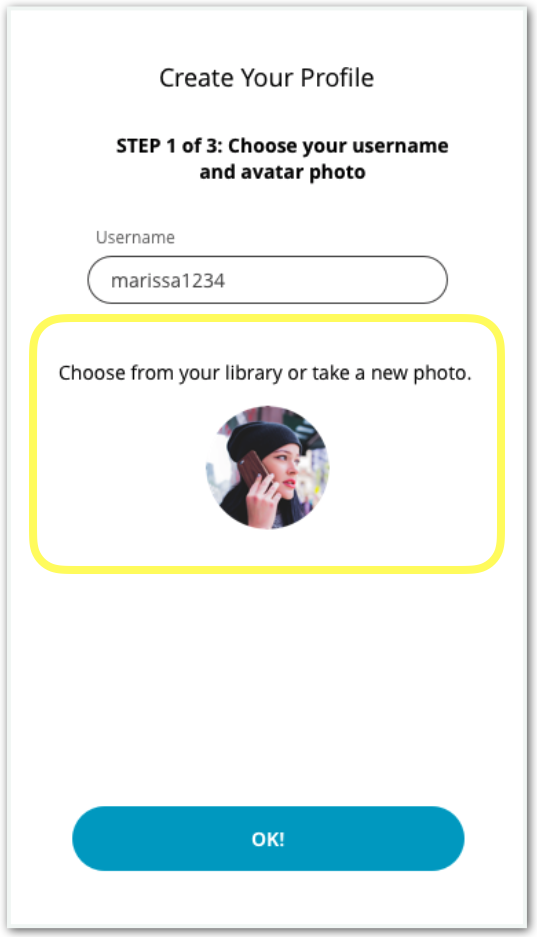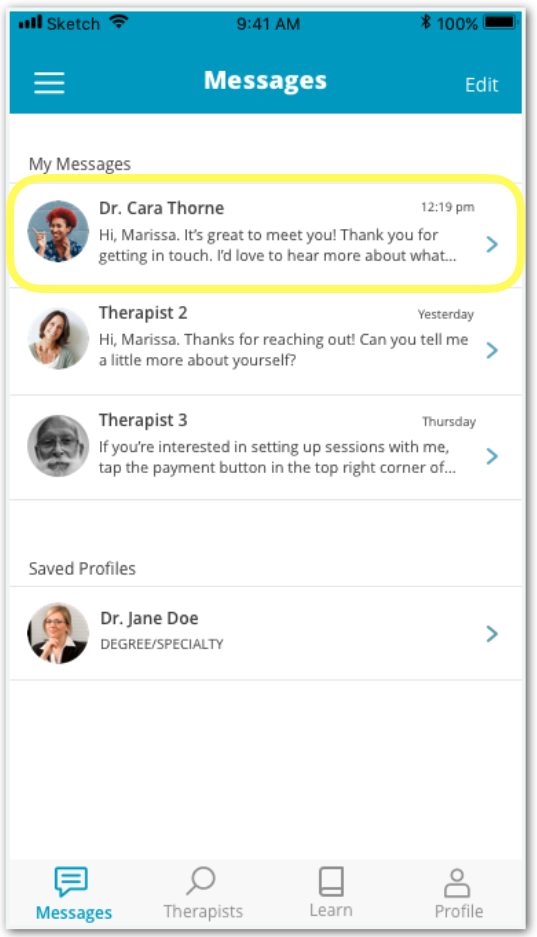The Brief
Because working on the UX of the EIS Portal App for Comcast was so enjoyable and thought-provoking, I decided to pursue a more formal UX education. I enrolled in an immersive online program through CareerFoundry’s UX School to expand my knowledge and skills. In the main section of the course, students choose between 3 project options. I chose the Expert app: “enable anyone, anywhere to instantly chat with an expert in virtually any field.”
Considering barriers that people face when trying to access mental health resources, I chose to design Mindfully: a communication tool that helps people find and connect with a therapist that truly suits their needs - anytime, anywhere.
I used a design thinking approach because I needed to quickly work out possible solutions for an MVP, and then keep building, measuring, and learning from my iterations. A leaner process helped me to quickly define the most important features of the app and to clarify how they would need to work together to create a useful end product.
Discovery
Competitive Analysis
I started this project by looking at the existing market for therapy apps. I analyzed two primary competitor apps: 7 Cups and Talkspace. I created a competitor profile with SWOT analysis for each company.
Problem Statement & Hypothesis
Problem Statement: Our users need a way to connect and communicate with licensed therapists of various specialties, because they need to be able to access high-quality therapy services from anywhere.
Hypothesis: We believe a mobile app that allows users to find and connect with remote therapists will help reduce obstacles to mental health care and will translate to a more empowering experience than our competitors currently offer.
Understanding the Problem
I started planning for user interview sessions by establishing my goals:
What do I already know?
There is an existing market for therapy and mindfulness apps
There are a variety of types of therapy that people seek in-person (psychotherapy, cognitive behavioral therapy, music therapy, etc)
People have many different kinds of experiences with in-person therapy - positive, neutral, and negative
Barriers like cost, time, and geographical location reduce people’s access to mental health care
What do I need know?
User’s thoughts and feelings about therapy apps
Pain points users have experienced with in-person therapy
What elements of their physical environment make them feel calm and comfortable
What traits they seek when looking for a new therapist
What are the leftover unknowns?
If people would be interested in trying out different therapists before purchasing a subscription
How current Talkspace users feel about their experience - why did they choose Talkspace? Are they fulfilled? Are they unsatisfied?
Talking to Users
Initially, I started with 3 interviewees - two of whom had never used therapy apps and one who had. I looked for participants who had experiences with therapy themselves, or as a part of their job/studies.
Interviewee #1: 29 years old, female, Sociology student at University of Maryland
Interviewee #2: 35 years old, male, former social worker, currently working at a food co-op in San Fransisco
Interviewee #3: 29 years old, female, owner of a vegan bakery, Talkspace user
All of the interviewees had tried in-person therapy in the past. They each spoke to positive and negative experiences, but maintained belief therapy’s helpfulness.
Interviewees 1 and 2 expressed hesitation about therapy apps - they were more comfortable with in-person experiences than sessions via screen.
Interviewees 1 and 3 were very transparent about their wants, needs, and expectations of a therapist, while Interviewee 2 had less of an idea of what he would want to look for in a therapist.
Interviewee 3 is a current Talkspace user and spoke very highly of her experiences using the app.
After my initials interviews, I realized that my understanding of the problem with current therapy app solutions would be better illustrated if I spoke to another therapy app user, so I found Interviewee #4: 31 years old, genderqueer, hairdresser, new Talkspace user.
From the Talkspace users (interviewees 3 and 4) specifically, I learned that:
They both have demanding jobs with erratic schedules
They both talked about coming from a generation where talking to strangers on the internet was commonplace - they had both developed meaningful relationships behind screens using tools like AIM (AOL Instant Messenger)
They are both very open to trying out different types of therapy methods
They both self-identify as being “non-traditional” and are hesitant of judgmental therapists
High-level Takeaways
All four participants:
Had experience with therapy prior to this interview - therapy is common within the key demographic
Expressed interest in learning about or engaging in different types of therapies
Took a surprisingly long time to think about question # 5 (“What are some personality traits that make you feel comfortable opening up to someone?”). It felt like the type of person they’d be talking to is very important to them
Wanted to be engaged by their therapist - to feel listened to, challenged, and respected
Described anonymity as being less important
Other key takeaways:
There is an existing population that is actively excited about therapy apps
Time, money, and access are common barriers to accessing therapy
There is still skepticism concerning therapy apps when it comes to having the “person-to-person” connection, though each participant had positive experiences talking on the phone with a therapist in the past
There may not be a lot of word-of-mouth communication about therapy apps
Personas
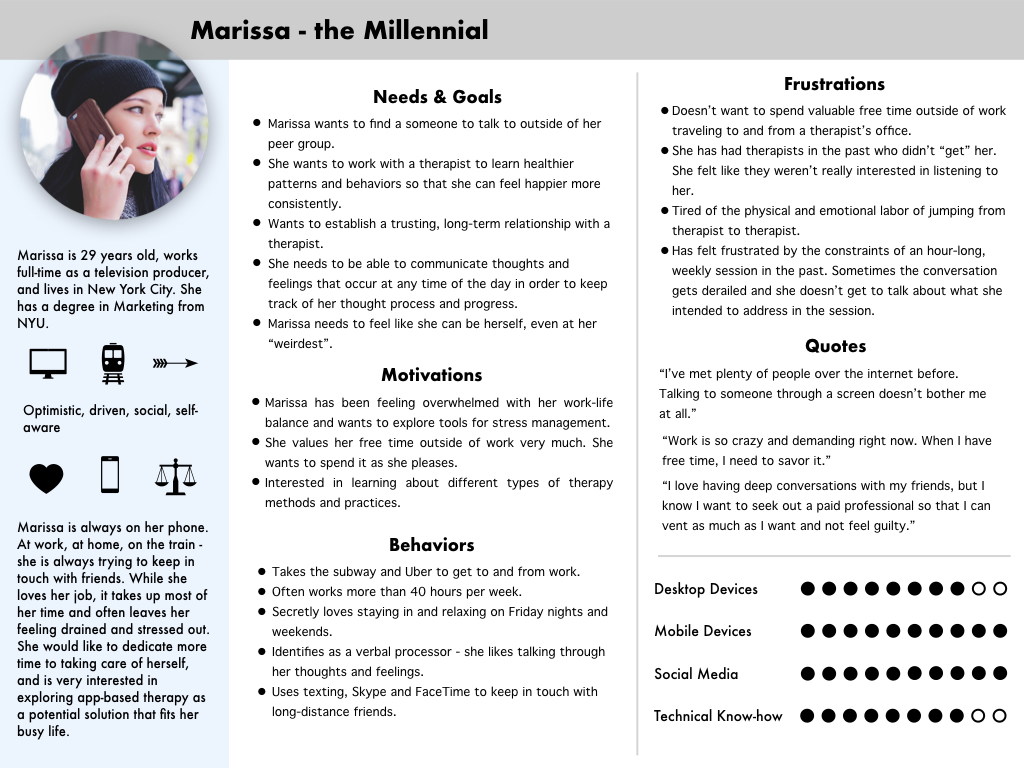
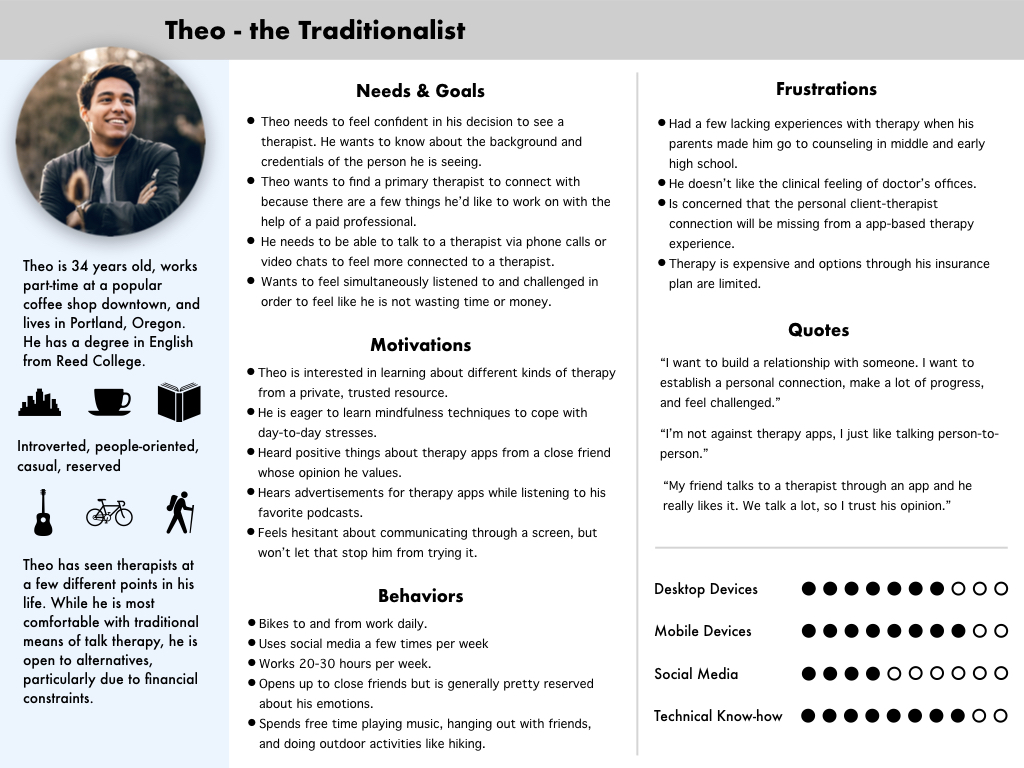
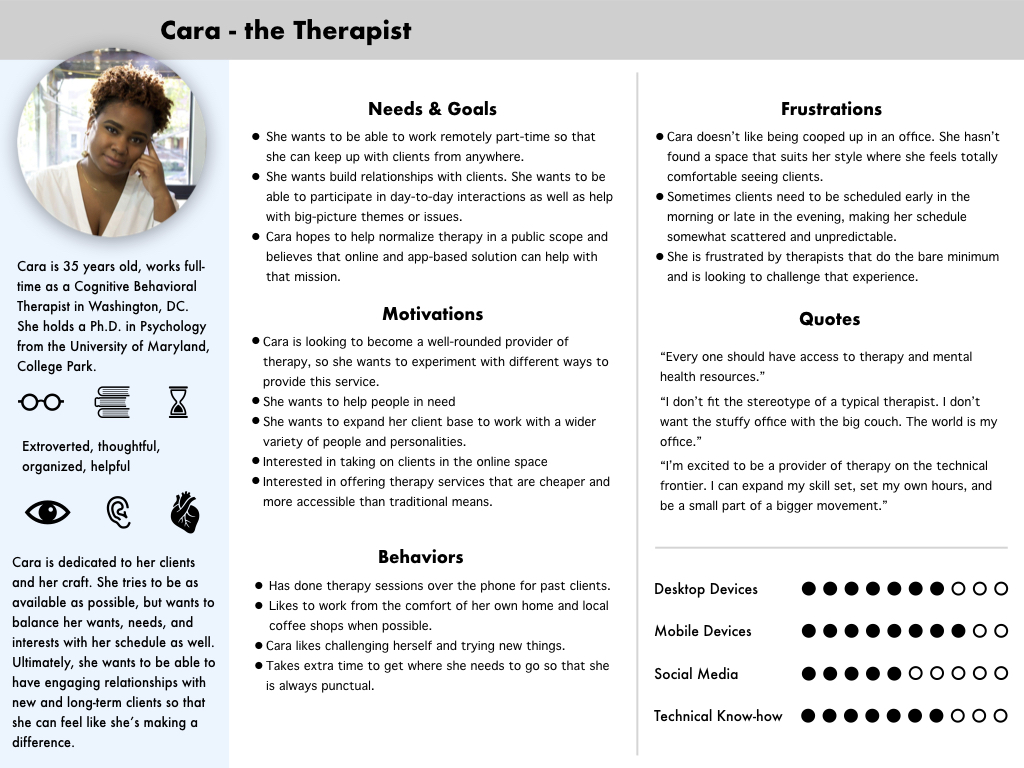
Marissa the Millennial represents the primary user of Mindfully - she grew up on the internet and is no stranger to communicating via a screen. This persona is based on feedback provided by current therapy-app-users that I interviewed. She is my primary persona and my guiding light.
Theo the Traditionalist has tried traditional therapy in the past but feels unsatisfied by the results - he is a great target for conversion to app-based therapy. He was created based on feedback from users who were more skeptical of therapy sessions via phone or screen.
Cara the Therapist represents the ideal therapist that each of my interviewees spoke about wanting to talk to. She is engaging, responsive, and respectful of her clients.
User Journey Mapping

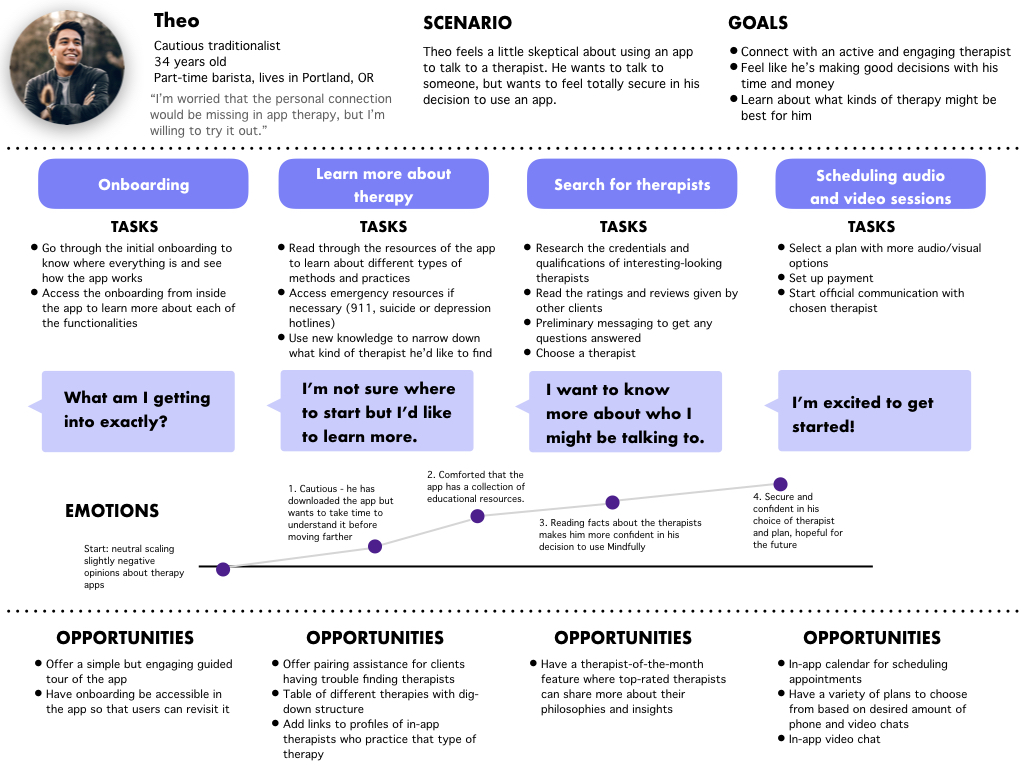
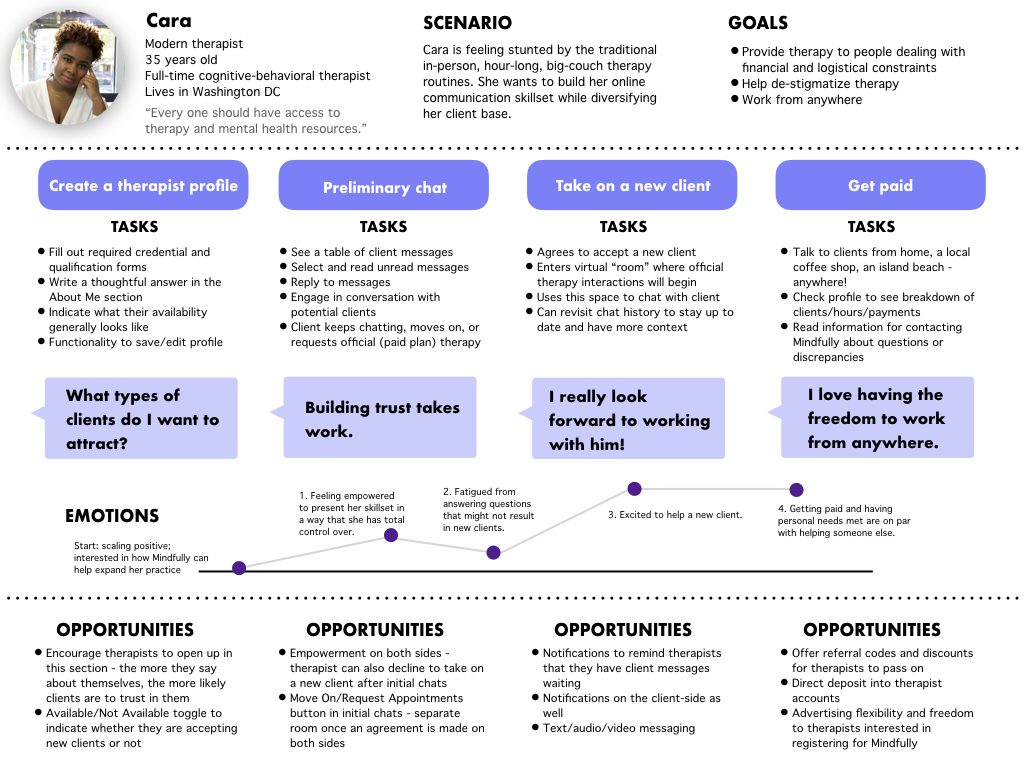
User Flows
I analyzed tasks that could be completed in the app from the perspective of Marissa Millennial. I then created user flows to start fleshing out the necessary steps and screens it would take to complete basic these tasks.
Building
Making an Information Architecture
Originally, I used Keynote to make the Information Architecture (IA) for Mindfully. My first few versions of the IA didn’t feel totally accurate, so I reorganized it a few times. After a consultation with my mentor, I decided to try Draw.io and follow a more interaction-based framework.



Iterative Wireframes
My first ideation sketches for user flows were (very) quick and dirty, with a Sharpie and graph paper. My designs progressed in clarity and fidelity with iterative wireframes. Mindfully is ultimately a tool for easing stress, so it’s interface needed to stay minimalistic with each iteration.
Low-Fidelity Main Navigation
Iterative Main Navigation



Low-Fidelity in Balsamiq:
Added “Saved Profiles” to Message screen so users could have fast access to interesting-looking therapists
Added a non-arrow button to the Find a Therapist cells
Continued exploring how “Plans” could work in the the My Profile section
Mid-Fidelity in Sketch:
Reverted Message cells to native-looking UI
Changed the Learn icon to an eye to see if users understood or preferred a more holistic feeling
Moved info about “plans” to the hamburger menu to clarify the main features of My Profile
High-Fidelity in Sketch:
Added detailed content to the Message screen to clarify the therapist's roles
Reverted the Learn icon back to a book after A/B testing indicated users preferred it
Made updates to My Profile to reflect the account creation process - password, 3 words, a more realistic About Me section
Low-Fidelity Wireframes
As each of my user flows became more fleshed out, I started translating my basic flows to the digital space. To start, I laid out on 3 flows: messaging a new therapist, starting a plan with a therapist, and creating a user profile.
Mid- & High-Fidelity Wireframes
Validation
Putting Navigation to the A/B Test
A/B test 1 (left) and A/B test 2 (right)
I A/B tested the main navigation of the app to see if users prefer the “search therapists” icon in the tab navigation, or if placing a simple icon in the top right corner would be more intuitive.
I ran two different A/B tests because test #1 had changes to the icon and the location of the icon. This offered too many variables for judgement, so I ran a second test with the same search icon but in a different location.
In total, 17 people participated in the second preference test. Option # 2 had a slightly higher success rate by one vote, which was not enough of a difference to be statistically significant. I choose to stick with the navigation of option # 1. The icon, placement, and text from option # 1 will add more clarity for new users who could benefit from having more context.
Usability Testing
With a high-fidelity prototype in-hand, I recruited 6 participants for my usability testing. Four sessions happened in-person and two were conducted remotely via Skype and Google Hangouts. I asked participants to complete direct and scenario tasks using Mindfully.
After all of the sessions were completed, I analyzed the feedback with an affinity map and a rainbow spreadsheet. Mapping the frequency of errors helped to inform a more formal test report that outlined and ranked the top issues that arose during testing and offered suggestions for possible remedies.
I learned that that my top 5 usability issues were:
Relationship with therapist is unclear (high priority)
Confusion about what to put in the profile (high priority)
Difference between the plans is unclear (medium priority)
Search functionality is not clear (low priority)
“Start Plan” button is unclear (low priority)
Iterating With Validation
I made changes to my wireframes to resolve the errors and address the negative feedback from my usability tests.
Issues 1 & 5:
Added clearer copy to show a relationship example
Labeled the chat to give the user more context
Included images to show who was talking
Replaced the "start plan" text button with an icon
Issue 2: What goes in a profile?
Separated the introduction to profile creation from step 1
Improved copy to guide and inform the tester/user
Addressed privacy concerns by clarifying when/with whom user profiles are shared
Issue 3:
Gave more description about each plan to show the points of difference
Increased the visibility of the instructions
Issues 1 & 4:
Added copy to the first cell to give the tester/user a better idea of what therapists do and how they are presented
Added placeholder text to the search bar to guide the user’s search process
Peer Review
I invited 5 fellow UX designers to peer review Mindfully via comments in InVision. Out of 25 comments, I chose to address the top 8 that were in the scope of the project and would have the most positive impact on the usefulness and usability.
Reworded and repositioned the text.Updated the InVision prototype to have more intuitive swiping interaction.
Replaced the “Sign Up/Login” labels with buttons that adhere to my style guide.
Added a screen after the camera is selected that shows a more realistic image of a user to indicate the action of adding a photo.
Increased the font size by 2 points to make the message text more legible.
Used consistent naming throughout the prototype to more clearly demonstrate the flow.
Changed the title to “Setup Payment” to save space and make a clearer call to action.
Included the username in the basic info, but I didn’t remove the email or password fields.
Iterating for Accessibility
I increased the size of the text and the size of the buttons for sign up and login. Not only does it make the buttons more accessible, it actually makes them more adherent to my style guide. I also changed the color of the swipe-guide dots to make them higher contrast on each of the onboarding screens.
To help guide the user during the sign up, login, and forgot password processes, I added small glyphs to the fields. Because they are on the right edge of the field, the glyphs won’t be covered by text or disappear at any point.
I replaced the flat lines with text fields that are more recognizable and in line with the standards set in my style guide. I added the numbers on the outside of the fields and added some more detail to the directions to reduce the cognitive load and help keep the user on track.
I checked the ratio of #9B9B9B text on a #FFFFFF background and found that it did not meet A, AA, or AAA standards. So I changed the color of all #9B9B9B to #4A4A4A, making it A, AA, and AAA compliant.
I removed the suggestion text from inside of the search bar. I put it below the bar so that it would never be covered up or disappear. I made this text higher contrast by changing the color to #4A4A4A.I also increased the font weight of the search term so that it would have higher contrast inside of the search.
Conclusion
Thank you for viewing the process behind Mindfully! Check out the current prototype in Figma.




